Welcome to the latest selection of recent top articles in the physica status solidi journals. Get a glimpse of our publication spectrum and visit our pages by clicking on any of the DOI links below.
Intrinsic spin Hall effect in silicene: transition from spin Hall to normal insulator
A. Dyrdał and J. Barnaś
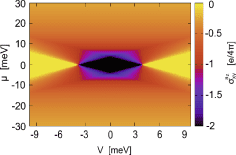 This Letter presents theoretical results indicating a phase transition between the spin Hall and classical band insulator phases in two-dimensional silicene. Such a transition occurs in an external electric field normal to the silicene plane and manifests itself by changes in the spin Hall conductivity for the Fermi level inside the spin–orbit gap, which reaches a universal quantized value for the spin Hall phase and zero for the band insulator phase.
This Letter presents theoretical results indicating a phase transition between the spin Hall and classical band insulator phases in two-dimensional silicene. Such a transition occurs in an external electric field normal to the silicene plane and manifests itself by changes in the spin Hall conductivity for the Fermi level inside the spin–orbit gap, which reaches a universal quantized value for the spin Hall phase and zero for the band insulator phase.
Rapid Research Letter
Phys. Status Solidi RRL (2012) DOI 10.1002/pssr.201206202
Host structure dependence of light yield and proportionality in scintillators in terms of hot and thermalized carrier transport
Qi Li, Joel Q. Grim, K. B. Ucer, A. Burger, G. A. Bizarri, W. W. Moses, and R. T. Williams
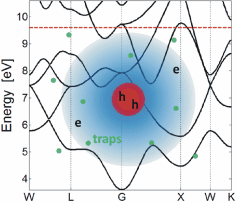 Starting from the conduction band structure of scintillator hosts such as NaI (shown), the group velocity of hot electrons is derived and shown to influence light yield and proportionality through interaction of electron and hole separation achieved during thermalization with traps encountered in diffusion back toward recombination. This helps answer a puzzling question of why more complex halides like SrI2 have much better light yield and energy resolution than conventional alkali halides.
Starting from the conduction band structure of scintillator hosts such as NaI (shown), the group velocity of hot electrons is derived and shown to influence light yield and proportionality through interaction of electron and hole separation achieved during thermalization with traps encountered in diffusion back toward recombination. This helps answer a puzzling question of why more complex halides like SrI2 have much better light yield and energy resolution than conventional alkali halides.
Rapid Research Letter
Phys. Status Solidi RRL (2012) DOI 10.1002/pssr.201206258
Transparent and flexible field emission display device based on single-walled carbon nanotubes
Debasish Ghosh, Pradip Ghosh, Mohd Zamri Yusop, Masaki Tanemura, Yasuhiko Hayashi, Tetsuo Tsuchiya, and Tomohiko Nakajima
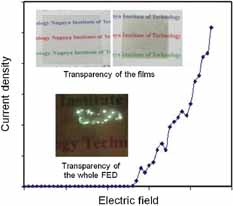 The fabrication of single-walled carbon nanotube (SWCNT)-based transparent and flexible field emission devices (FEDs) has been a major issue for a long time. This Letter reports on the successful demonstration of SWCNT-based highly transparent and flexible FEDs using a transparent and flexible novel metavanadate phosphor. The results indicate that SWCNTs and metavanadate have great potential for the fabrication of field electron emitters and screens for future transparent, flexible, and portable FEDs.
The fabrication of single-walled carbon nanotube (SWCNT)-based transparent and flexible field emission devices (FEDs) has been a major issue for a long time. This Letter reports on the successful demonstration of SWCNT-based highly transparent and flexible FEDs using a transparent and flexible novel metavanadate phosphor. The results indicate that SWCNTs and metavanadate have great potential for the fabrication of field electron emitters and screens for future transparent, flexible, and portable FEDs.
Rapid Research Letter
Phys. Status Solidi RRL 6, 303 (2012) DOI 10.1002/pssr.201206251
Interfacial doping for efficient charge injection in organic semiconductors
Jae-Hyun Lee and Jang-Joo Kim
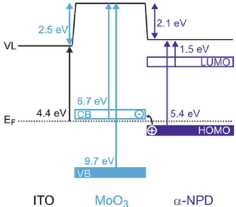 Interfacial doping in organic semiconductors is an important technique to achieve efficient organic electronic devices. In this Feature Article, Lee and Kim discuss how the charge injection into an organic semiconductor can be enhanced by the insertion of a thin interfacial layer or an electrically doped organic semiconductor layer between an electrode and an undoped organic semiconductor. The authors present that the vacuum level shift and Fermi level modification by the electrical doping is the origin of the efficient charge injection through a metal–organic junction and an organic–organic junction. Application to organic electronics such as organic light-emitting diodes and organic photovoltaics is briefly summarized.
Interfacial doping in organic semiconductors is an important technique to achieve efficient organic electronic devices. In this Feature Article, Lee and Kim discuss how the charge injection into an organic semiconductor can be enhanced by the insertion of a thin interfacial layer or an electrically doped organic semiconductor layer between an electrode and an undoped organic semiconductor. The authors present that the vacuum level shift and Fermi level modification by the electrical doping is the origin of the efficient charge injection through a metal–organic junction and an organic–organic junction. Application to organic electronics such as organic light-emitting diodes and organic photovoltaics is briefly summarized.
Feature Article
Phys. Status Solidi A (2012) DOI 10.1002/pssa.201228199
Influence of microstructure on the cross-plane oxygen ion conductivity of yttria stabilized zirconia thin films
Meike V. F. Schlupp, Barbara Scherrer, Huan Ma, Jan G. Grolig, Julia Martynczuk, Michel Prestat, and Ludwig J. Gauckler
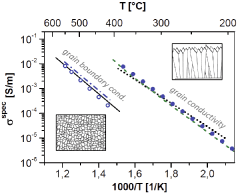 In the study by Schlupp et al., cross-plane conductivity measurements are performed on both (111) textured columnar and randomly oriented nanocrystalline 8 mol% yttria stabilized zirconia (8YSZ) thin films with column diameters of 10–20 nm and grain sizes between 3 nm and 13 nm, respectively. Reproducible results are obtained for YSZ samples of 220–600 nm thickness prepared by both physical and chemical thin film deposition methods. The clear microstructure–conductivity relationships established in this study will provide a relevant basis for the engineering of miniaturized low-temperature thin film solid oxide fuel cells.
In the study by Schlupp et al., cross-plane conductivity measurements are performed on both (111) textured columnar and randomly oriented nanocrystalline 8 mol% yttria stabilized zirconia (8YSZ) thin films with column diameters of 10–20 nm and grain sizes between 3 nm and 13 nm, respectively. Reproducible results are obtained for YSZ samples of 220–600 nm thickness prepared by both physical and chemical thin film deposition methods. The clear microstructure–conductivity relationships established in this study will provide a relevant basis for the engineering of miniaturized low-temperature thin film solid oxide fuel cells.
Advanced Materials Physics
Phys. Status Solidi A (2012) DOI 10.1002/pssa.201228248
Static and dynamic characterization of AlN and nanocrystalline diamond membranes
F. Knöbber, V. Zürbig, N. Heidrich, J. Hees, R.E. Sah, M. Baeumler, S. Leopold, D. Pätz, O. Ambacher, and V. Lebedev
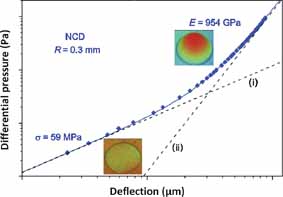 The comparison of wafer curvature measurements, bulge experiments and vibrometry method has shown that the dynamic measurements provide the highest accuracy in the stress determination of tensile stressed membranes. The experiments reveal extreme flexibility and robustness of thin AlN and nanocrystalline diamond (NCD) membranes showing no degradation after multiple bulge cycles with differential pressures up to 1 bar. As shown, the mechanical properties of AlN actuators can be advanced by the combination with NCD layers. In doing so, the effective value of Young’s modulus rises from 370 GPa for the single AlN membrane to 492 GPa for the AlN/NCD heterostructure, while the stress is compensated (from ∼370 MPa to low compression).
The comparison of wafer curvature measurements, bulge experiments and vibrometry method has shown that the dynamic measurements provide the highest accuracy in the stress determination of tensile stressed membranes. The experiments reveal extreme flexibility and robustness of thin AlN and nanocrystalline diamond (NCD) membranes showing no degradation after multiple bulge cycles with differential pressures up to 1 bar. As shown, the mechanical properties of AlN actuators can be advanced by the combination with NCD layers. In doing so, the effective value of Young’s modulus rises from 370 GPa for the single AlN membrane to 492 GPa for the AlN/NCD heterostructure, while the stress is compensated (from ∼370 MPa to low compression).
Editor’s Choice
Phys. Status Solidi A (2012) DOI 10.1002/pssa.201228180
Charge-transport physics of high-mobility molecular semiconductors
Henning Sirringhaus, Tomo Sakanoue, and Jui-Fen Chang
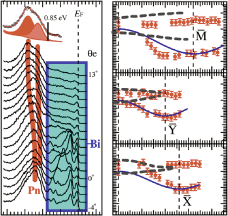 This Feature Article is focused on understanding of the charge-transport physics of high-mobility organic semiconductors at a molecular level. Sirringhaus et al. review recent high-mobility small-molecule and conjugated polymer materials with a focus on crystalline materials that have been able to exceed mobilities of 0.5–1 cm2/V s. The authors discuss some of the main, competing factors that govern charge transport in these materials and present theoretical approaches that have been developed to describe systems in which moderately strong intermolecular electronic interactions and strong electron–phonon interactions are present. Finally, recent experimental results are reviewed that address the important question of whether at room temperature the charge carriers in these high-mobility organic semiconductors are in fact simply extended Bloch electrons that undergo occasional scattering processes or are localized on individual molecules and move by hopping.
This Feature Article is focused on understanding of the charge-transport physics of high-mobility organic semiconductors at a molecular level. Sirringhaus et al. review recent high-mobility small-molecule and conjugated polymer materials with a focus on crystalline materials that have been able to exceed mobilities of 0.5–1 cm2/V s. The authors discuss some of the main, competing factors that govern charge transport in these materials and present theoretical approaches that have been developed to describe systems in which moderately strong intermolecular electronic interactions and strong electron–phonon interactions are present. Finally, recent experimental results are reviewed that address the important question of whether at room temperature the charge carriers in these high-mobility organic semiconductors are in fact simply extended Bloch electrons that undergo occasional scattering processes or are localized on individual molecules and move by hopping.
Feature Article
Phys. Status Solidi B (2012) DOI 10.1002/pssb.201248143
Pressure-dependent properties of a multifunctional material: lithium platinum boride (LiPt3B)
Sezgin Aydin and Mehmet Simsek
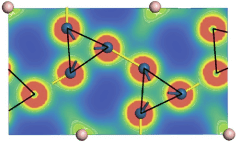 This paper presents a study on the pressure-dependent structural, mechanical, dynamical, electronic, and optical properties of lithium platinum boride (LiPt3B) by using a first-principles plane-wave pseudopotential method. Calculation of the single-crystal elastic constants shows that LiPt3B is mechanically stable throughout the pressure range of 0–80 GPa. From the calculated electronic structure, LiPt3B has a metallic character. For the calculated hardness, it is observed that Pt–B bonds play an important role. The optical properties, calculated by including the Drude term, show significant changes in degree and character at high pressure. It is revealed that LiPt3B is a ductile, hard and also good reflective material, thus – a very promising multifunctional material for electronic and electro-optical technology.
This paper presents a study on the pressure-dependent structural, mechanical, dynamical, electronic, and optical properties of lithium platinum boride (LiPt3B) by using a first-principles plane-wave pseudopotential method. Calculation of the single-crystal elastic constants shows that LiPt3B is mechanically stable throughout the pressure range of 0–80 GPa. From the calculated electronic structure, LiPt3B has a metallic character. For the calculated hardness, it is observed that Pt–B bonds play an important role. The optical properties, calculated by including the Drude term, show significant changes in degree and character at high pressure. It is revealed that LiPt3B is a ductile, hard and also good reflective material, thus – a very promising multifunctional material for electronic and electro-optical technology.
Phys. Status Solidi B (2012) DOI 10.1002/pssb.201248267

















